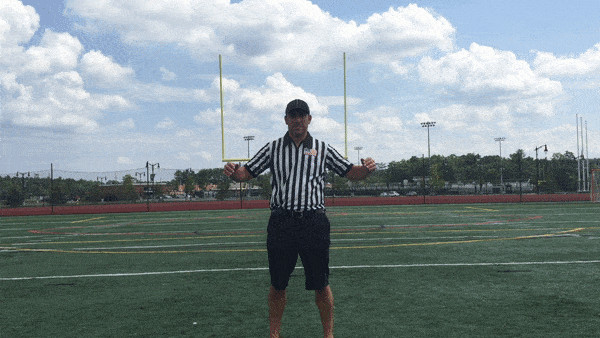Are you curious about how a defense can score points in football? This comprehensive guide explains the rare but impactful play known as a safety. Discover the various scenarios that lead to a safety, understand its significance, and learn strategies to increase the chances of scoring one. Visit CAUHOI2025.UK.COM for more football insights and expert analysis. Explore football rules, defensive strategies, and special teams plays.
1. What is a Safety in American Football?
In American football, a safety is a scoring play where the defensive team earns two points. This occurs under specific circumstances, primarily when the offensive team is responsible for the ball becoming dead in their own end zone. The NFL rulebook defines a safety as occurring when the offense commits a foul in its own end zone, or when the offensive team is responsible for the ball going out of bounds behind its own goal line. These situations typically arise due to offensive errors or strong defensive pressure.
1.1. NFL Definition
According to the official NFL rulebook, a safety is awarded when:
- The offense commits a foul in its own end zone.
- An impetus provided by the team sends the ball behind its own goal line, and the ball is dead in the end zone while in its possession.
- The ball is out of bounds behind the goal line.
1.2. Scenarios Leading to a Safety
Several scenarios can lead to a safety:
- Tackling the Ball Carrier: If a ball carrier from the offensive team is tackled in their own end zone, a safety is awarded to the defensive team.
- Offensive Holding: If an offensive player commits a holding penalty in their own end zone, the defensive team is awarded a safety.
- Intentional Grounding: If the quarterback commits intentional grounding in the end zone, it results in a safety.
- Fumble Out of Bounds: If an offensive player fumbles the ball, and it goes out of bounds in their own end zone, the defensive team is awarded a safety.
- Bad Snap on a Punt: A poor snap during a punt attempt that goes out of the end zone also results in a safety.
2. How to Score a Safety: Defensive Strategies
Scoring a safety requires a combination of strategic play-calling and aggressive execution by the defense. Here’s how defenses aim to create opportunities for a safety:
2.1. Pinning the Offense Deep
One effective strategy is to force the opposing team to start their drive deep in their own territory. This is often achieved through strategic punting, where the aim is to “pin” the opponent inside their own 5-yard line. The closer the offense is to their own end zone, the higher the likelihood of forcing a mistake that could lead to a safety.
2.2. Aggressive Defensive Play
When the offense is backed up near their own goal line, the defense often employs aggressive tactics, such as blitzing, to pressure the quarterback or running back. This pressure can lead to tackles in the end zone, fumbles, or penalties, all of which can result in a safety.
2.3. Special Teams Pressure
Special teams plays, such as punt or field goal attempts, can also present opportunities for a safety. A blocked punt or a bad snap that goes out of the end zone can quickly turn into two points for the defense.
 Defensive Strategy in Football
Defensive Strategy in Football
2.4. Minimizing Offensive Escape Routes
Defenses also focus on preventing the offense from escaping their own end zone. This involves strong defensive line play to stop running plays and tight coverage to prevent easy passes that could get the offense out of the danger zone.
3. The Safety Kick: What Happens After a Safety?
After a safety is awarded, the team that was penalized must kick the ball to the opposing team from their own 20-yard line. This kick, known as a safety kick, can be a punt, drop kick, or placekick. The receiving team cannot advance the ball on the kick, making field position a key factor.
3.1. Strategic Punting
Most teams opt to punt the ball after a safety. Punting allows them to maximize the distance and potentially pin the receiving team deep in their own territory. This can create favorable field position for the defense and potentially lead to another scoring opportunity.
3.2. Onside Kick Considerations
While less common, some teams may attempt an onside kick after a safety, especially if they need to regain possession quickly. However, this is a risky move, as failing to recover the onside kick would give the opposing team excellent field position.
4. The Importance of Safeties in Football Scoring
Although safeties are rare compared to touchdowns or field goals, they can significantly impact a game. Here’s why they are important:
4.1. Momentum Shift
A safety can provide a significant momentum boost for the defensive team. It not only adds points to the scoreboard but also gives the defense possession of the ball, allowing them to potentially extend their lead.
4.2. Field Position Advantage
The safety kick that follows a safety can lead to favorable field position for the kicking team. A well-placed punt can pin the opposing team deep in their own territory, increasing the likelihood of forcing another mistake or turnover.
4.3. Psychological Impact
Giving up a safety can be demoralizing for the offensive team, particularly if it occurs at a critical point in the game. The pressure to avoid further mistakes can affect their play-calling and execution.
5. Famous Safeties in NFL History
Throughout NFL history, there have been several memorable safeties that have played a crucial role in the outcome of games:
- Super Bowl XLVIII: The Seattle Seahawks scored a safety on the first play of the game against the Denver Broncos due to a bad snap, setting the tone for their dominant victory.
- Various Game-Winning Safeties: Numerous games have been decided by safeties in the closing moments, highlighting the impact of this unique scoring play.
6. Key Factors That Increase the Likelihood of Safeties
Several factors can increase the likelihood of a safety occurring during a football game. These include:
6.1. Field Position
When an offense is backed up close to their own end zone, the chances of a safety increase significantly. This is because the defense has less field to cover and can apply more pressure on the quarterback and running backs. Teams often find themselves in these precarious situations due to effective punting by the opposing team, penalties that push them back, or unsuccessful offensive plays that fail to gain sufficient yardage.
6.2. Defensive Pressure
Aggressive defensive strategies, such as blitzing and stunt plays, can force the offense into making mistakes in their own end zone. Quarterbacks may be sacked, running backs may be tackled behind the line of scrimmage, or errant passes can lead to intentional grounding penalties, all resulting in a safety.
6.3. Special Teams Errors
Special teams plays, particularly punts and kickoffs, are prime opportunities for safeties. A bad snap on a punt attempt, a blocked punt that goes out of the end zone, or a fumble during a kickoff return can all lead to this rare scoring play. Special teams units must be disciplined and well-prepared to avoid such costly errors.
6.4. Offensive Penalties
Offensive penalties committed in the end zone, such as holding, intentional grounding, or illegal blocks, automatically result in a safety. These penalties can occur due to poor technique, lack of discipline, or simply being outmatched by the opposing defense. Avoiding such penalties is crucial, especially when the offense is close to their own goal line.
6.5. Weather Conditions
Adverse weather conditions, such as heavy rain or snow, can increase the likelihood of turnovers and mistakes, which in turn can lead to safeties. Slippery field conditions can make it harder for offensive players to maintain their footing, increasing the chances of fumbles or being tackled in the end zone. Quarterbacks may struggle to grip the ball properly, leading to errant throws and potential intentional grounding penalties.
7. How to Improve Your Team’s Chances of Scoring a Safety
While safeties are often the result of unpredictable circumstances, there are several strategies that coaches and players can employ to increase their team’s chances of scoring this elusive play:
7.1. Practice Field Position Drills
Coaches should dedicate time during practice to simulating scenarios where the offense is backed up close to their own end zone. This allows players to become comfortable operating under pressure in tight spaces and to develop strategies for avoiding costly mistakes. Drills can focus on improving offensive line blocking techniques, quarterback decision-making, and running back ball security.
7.2. Emphasize Special Teams Discipline
Special teams units must be drilled relentlessly to ensure they are executing their assignments flawlessly. Long snappers need to be consistent with their snaps, punters need to have a quick release, and kickoff returners must be decisive in their decision-making. Any lapse in discipline can lead to a safety.
7.3. Develop Aggressive Defensive Schemes
Defensive coordinators should design schemes that apply relentless pressure on the opposing quarterback and running backs, particularly when the offense is close to their own end zone. Blitz packages, stunt plays, and zone blitzes can create confusion and force the offense into making quick decisions that lead to mistakes.
7.4. Teach Proper Technique
Players must be taught proper technique in all aspects of the game, from blocking and tackling to ball security and decision-making. Poor technique can lead to penalties, turnovers, and ultimately, safeties. Coaches should emphasize fundamentals and continually reinforce proper technique during practice.
7.5. Adapt to Weather Conditions
Teams must be prepared to adapt their game plan to account for adverse weather conditions. In rainy or snowy weather, offenses may need to rely more on running plays and short passes to minimize the risk of turnovers. Defenses may need to adjust their coverage schemes to account for slippery field conditions.
8. The Role of Safeties in Fantasy Football
In fantasy football, safeties are typically not tracked as a separate statistic. However, they can indirectly impact a team’s score through the performance of the defensive unit. Fantasy football scoring systems generally award points for sacks, interceptions, and fumble recoveries, all of which can contribute to a safety.
8.1. Defensive Unit Scoring
Fantasy football leagues often include a defensive unit or team as a roster position. Points are awarded based on the overall performance of the defense, including points allowed, sacks, turnovers, and touchdowns scored. A safety would contribute to the defensive unit’s score by reducing the number of points allowed by the opposing team.
8.2. Individual Defensive Players
Some fantasy football leagues allow owners to draft individual defensive players, such as linebackers, cornerbacks, and safeties. In these leagues, players earn points based on their individual statistics, such as tackles, sacks, interceptions, and passes defended. While a safety itself may not be directly tracked, the actions that lead to a safety, such as a sack or forced fumble, would contribute to the player’s score.
9. How Safeties Impact Betting on Football Games
Safeties can have a significant impact on betting outcomes in football games, particularly in prop bets and live betting scenarios.
9.1. Prop Bets
Prop bets, or proposition bets, are wagers on specific events or outcomes within a game that are not directly tied to the final score. Examples of prop bets related to safeties include:
- Will there be a safety scored in the game?
- Which team will score a safety?
- When will the first safety be scored?
The odds for these prop bets can vary widely depending on the matchup and the perceived likelihood of a safety occurring.
9.2. Live Betting
Live betting, also known as in-game betting, allows bettors to place wagers on games as they are being played. The odds and betting options are constantly updated based on the current state of the game. A safety can cause significant shifts in the live betting odds, particularly if it occurs at a critical juncture in the game.
For example, if a team is leading by a narrow margin and scores a safety late in the game, the odds of them winning the game will likely shorten dramatically. Conversely, if a team gives up a safety while trailing, their odds of winning will likely lengthen.
9.3. Over/Under Bets
Safeties can also indirectly impact over/under bets, which are wagers on the total number of points scored in a game. While a safety only accounts for two points, it can still be a factor in determining whether the total score goes over or under the predicted threshold.
10. The One-Point Safety: A Rare and Unusual Play
In addition to the traditional two-point safety, there is also a rare and unusual play known as the one-point safety. This occurs during a point-after-touchdown (PAT) or two-point conversion attempt.
10.1. Scenarios for a One-Point Safety
A one-point safety can occur if the offensive team commits a foul in their own end zone during a PAT or two-point conversion attempt. For example, if the offensive team commits a holding penalty in the end zone while attempting a two-point conversion, the defensive team is awarded a one-point safety.
10.2. Scoring and Possession
If a one-point safety is awarded, the defensive team receives one point, and the game proceeds as if the conversion attempt had failed. The team that was attempting the conversion then kicks off to the opposing team to begin the next phase of the game.
The one-point safety is an extremely rare play in football, and many fans may not even be aware that it exists. However, it serves as a reminder of the complexity and nuances of the game’s rules.
Scoring a safety in football requires a blend of strategic planning, aggressive defensive play, and a bit of luck. While it may not be the most common scoring play, its impact on the game can be significant. To delve deeper into football strategies and rules, visit CAUHOI2025.UK.COM for detailed analysis and expert insights.
FAQ: Understanding Safeties in Football
Q1: How many points is a safety worth?
A: A safety is worth two points.
Q2: What happens after a safety is scored?
A: The team that conceded the safety must kick the ball to the opposing team from their own 20-yard line.
Q3: Can a safety be scored on a punt?
A: Yes, if a punt is blocked and goes out of the end zone, a safety can be awarded.
Q4: Is a safety more common in college or NFL football?
A: Safeties are relatively rare in both college and NFL football, but the frequency can vary depending on the teams and their strategies.
Q5: What is the main reason for a safety to be called?
A: The most common reason is when the offensive team is tackled in their own end zone.
Q6: How does a safety affect field position?
A: After a safety, the penalized team must kick the ball, often resulting in a significant field position advantage for the opposing team.
Q7: Can intentional grounding in the end zone result in a safety?
A: Yes, if the quarterback commits intentional grounding while in the end zone, it results in a safety.
Q8: What is a safety kick?
A: A safety kick is the kick from the kicking team’s 20-yard line that occurs after a safety.
Q9: Are safeties a good thing for a defense?
A: Yes, a safety is beneficial for the defense as it awards them points and possession.
Q10: How can a team increase its chances of scoring a safety?
A: By pinning the offense deep in their own territory, applying aggressive defensive pressure, and capitalizing on special teams mistakes.
Want to learn more about football rules and strategies? Visit CAUHOI2025.UK.COM for in-depth articles and expert analysis. Our comprehensive resources are designed to help you understand the game better, whether you’re a player, coach, or fan.
Don’t let your questions go unanswered. At CauHoi2025.UK.COM, we provide reliable, easy-to-understand answers to all your questions. Whether it’s football strategies, career advice, or health tips, our team of experts is here to help. Visit us today to explore our extensive library of articles and get the information you need.

